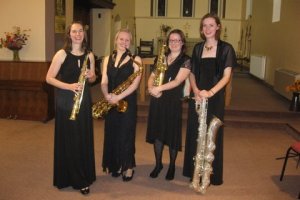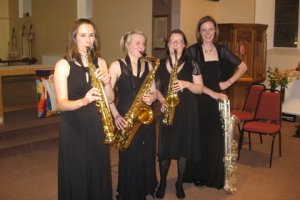Season 2012–2013
Saturday 6 October 2012
St Mary's Church, Inverurie
Saturday 3 November 2012
Kemnay Church Centre
Friday 18 January 2013
Kemnay Church Centre
Saturday 16 February 2013
Acorn Centre, Inverurie
Friday 29 March 2013
Inverurie Town Hall
Links
Event Sponsors
|
Sax Ecosse
Saturday 6 October 2012
8pm
St Mary's Church, Inverurie
(map)
Tickets £12.00, £9.00 (concession), £1.00 (children & full-time
students)
available at the door or from Morgan's Music Shop
Original listing
Review by Alistair Massey

The saxophone quartet Sax Ecosse made a return visit to St Mary's Church on Saturday
in a concert that was technically dazzling, engagingly informative and musically
challenging for both performers and listeners. Karen Dufour (soprano saxophone)
introduced the members of the quartet and each performer gave a "musical twirl"
to show off their instrument's particular character. On the alto saxophone was Michelle
Melvin; Gillian Skingley, a former pupil of Cults Academy, gave a flourish on the
tenor saxophone and Lynsey Payne went down to the depths with her baritone saxophone.
The group was founded in 2004 and are all former students of the Royal Academy of
Music and Drama in Glasgow. As well as concerts, they have been involved in many
educational workshops.
As Karen explained, the saxophone has only existed for a century and a half so many
pieces have to be specially arranged for it. The opening piece, the Fantasia and
Fugue in C minor BWV.536 by J. S. Bach was originally written
for organ. It features a double fugue, a Bach speciality. Here the lively first
theme and the tensely chromatic second theme are separately developed and then combined
to conclude the piece. The quartet skilfully balanced each part to display the polyphonic
craftsmanship.
In contrast to this were the Six Bagatelles by György Ligeti, a Hungarian
who emigrated to Austria during the Budapest Rising. Now free from state control,
he specialised in the "colour" of music. Stanley Kubrick of Space Odyssey 2001
fame used his music for his films. The pieces were little canvasses that conjured
up experiences and emotions in a jokey way, though the final Bagatelle was unsettling
with its persistent augmented fourths. This interval is nicknamed the "devil's interval".
Perhaps it depicted a horror movie — after all the composer was born in Transylvania!

The quartet's favourite Holberg Suite of 18th century style dances by Grieg
finished the first half. The next piece was the Allegro de Concert, the first
piece specifically composed for saxophone by Englishman Florio in 1879 for a group
of players in New York. Then a wander in the French countryside was evoked by a
Theme and Variations by Gabriel Pierné, a composer of the early 20th
century whose music is now almost unknown. This charming piece was handled beautifully.
For the finale, Sax Ecosse displayed their virtuosity and energy with the exhilarating
and rhythmically complex Quartet No.3 by Barbara Thomson. As she suffers
from Parkinson's disease, the composer subtitled her work as Body Language
and references to her illness are embedded in the score. In the musical texture,
jazz idioms were prominent but there were influences from a number of cultures such
as South America and the Middle East. After the appreciative applause a Hungarian
dance by Ferenc Farkas, Ugros, was played as an encore. These wild dances
were used by recruiting parties to entice young men into the Hungarian army... so
beware!
The next Inverurie Music Concert will feature Madeleine Mitchell (violin) and Nigel
Clayton (piano) on Saturday 3 November in Kemnay Church Centre at 8pm. See
www.inveruriemusic.co.uk for details.
Photos by John Hearne
|